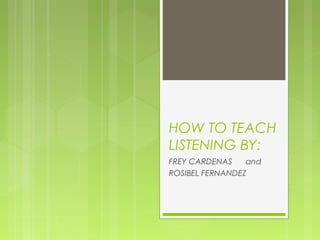
How to teach listening
- 1. HOW TO TEACH LISTENING BY: FREY CARDENAS and ROSIBEL FERNANDEZ
- 2. LISTENING Listening is the ability to identify and understand what others are saying. This involves understanding a speaker's accent or pronunciation, his grammar and his vocabulary, and grasping his meaning.
- 3. LISTENING AUDIO SEGMENTS You can also teach listening skills through audio segments of radio programs, online podcasts, instructional lectures and other audio messages. First, instruct students to prepare for listening by considering anything that they will want to learn from the content of the audio segment. Repeat this activity but instruct students to not take notes until the completion of the audio segment. Use shorter or longer audio segments.
- 4. LISTENING VIDEO SEGMENTS Anotherhelpful resource for teaching listening skills are video segments, including short sketches, news programs, documentary films, interview segments, and dramatic and comedic material. Aswith audio segments, select the portion and length of the video segment based on the skill level of your students. Withyour students, first watch the segment without any sound and discuss it together.
- 5. WHY TEACH LISTENING? Students hear different accents and varieties. Listening helps students to acquire language subconsciously. Listening is a receptive skill. Education. Mass communication.
- 6. ‘Pre- listening…’ During the pre- listening phase, teachers need to recognize that all students bring different backgrounds to the listening experience. Beliefs, attitudes, and biases of the listeners will affect the understanding of the message.
- 7. There are some strategies that students and teachers can use to prepare for a listening experience. They can:
- 8. 1 Activate Existing Knowledge: 4 Establish Purpose: 2 Build Prior Knowledge: TQLR Pre- listening 3 Review Standards for listening: 5 Use a listening Guide:
- 9. T -- Tune in Q -- Question TQLR L – Listen R -- Review
- 10. WHILE LISTENING: Connect: Find Meaning: Question: Make and confirm predictions: Make inferences: Reflect and evaluate:
- 11. Teachers can create listening guides to focus students' attention on the content, organization, or devices used by a speaker. The following is an example:
- 12. Sample listening Guide Name of student: ______________________________ Nature of spoken presentation: ___________________ Where heard: ________________________________ Name of speaker: _____________________________ Speaker’s expressed purpose: Qualifications of speaker: Main Idea(s) presented: Noteworthy features of presentation: In what ways was the talk effective? Ineffective? Why?
- 13. POST-LISTENING: Compare their notes in small groups. Encourage debates and answer questions. Write a summary of the main points and then compare. Make a list of any new vocabulary.
- 14. Students need to act upon what they have heard to clarify meaning and extend their thinking. Some examples follow. To begin with, students can ask questions of themselves and the speaker to clarify their understanding and confirm their assumptions. Students can review their notes and add information that they did not have an opportunity to record during the speech. Students can analyse and evaluate critically what they have heard. Students can review their notes and add information that they did not have an opportunity to record during the speech.
- 15. REMEMBER!!! Try to use as many different sources of listening material as you can: advertisements, news programs, poetry, songs, extracts from plays, speeches, lectures, telephone conversations, informal dialogues.
- 16. A SUCCESSFUL LISTENING ACTIVITY 5 Ideas to make the best listening activities ever!
- 17. 1 Reduce distractions and noise during the listening segment.
- 18. 2 makesure the equipment produces acceptable sound quality.
- 19. 3 Read or play the text a total of 2-3 times.
- 20. 4 Playa video clip with the sound off and ask students to make predictions about it.
- 21. 5 Give students a listening task to do between classes.
